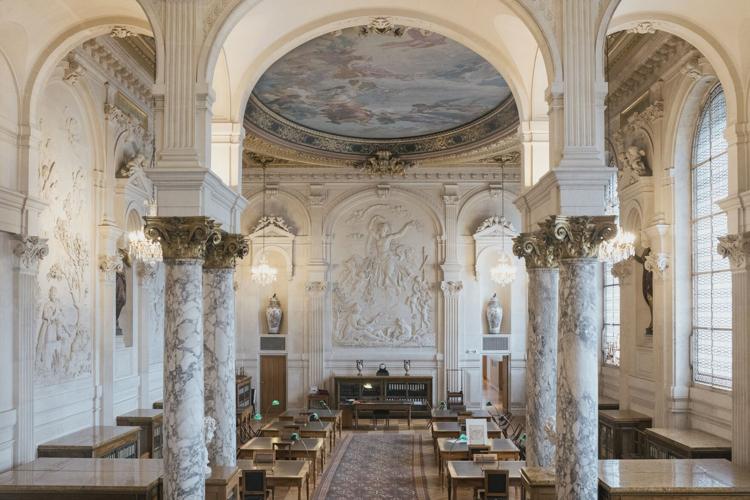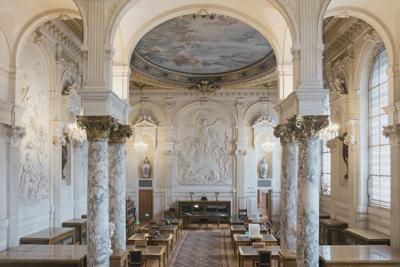Paris is a city of museums, nearly 150 by my unofficial count. Beyond the state-owned grandes dames ŌĆö the Louvre, the Mus├®e dŌĆÖOrsay and Versailles (if you define a palace as a museum) ŌĆö there are free city museums (the Petit Palais and the Carnavalet, among them), and museums dedicated to one artist (Auguste Rodin, Pablo Picasso), one writer (Honor├® de Balzac, George Sand), one subject (perfume, playing cards), even one activity (counterfeiting, smoking).
But some of the most intriguing collections may be ones youŌĆÖve never heard of, sequestered in hidden spaces.
Here are three museum spaces that even many Parisians have never heard of:
Consultation Room for Prints and Drawings at the Louvre┬ĀTucked away at the far end of the sprawling Louvre is an intimate, little-visited wing: the Graphic Arts DepartmentŌĆÖs Consultation Room, the entrance of which, guarded by two stone lions, faces the Carrousel Garden abutting the Tuileries Garden. There you can see works by some of the worldŌĆÖs most famous artists up close, out of their frames, for as long as you want.
The Louvre does not advertise how to visit the Consultation Room. The department houses almost a quarter of a million drawings, pastels, miniatures, prints, engraved plates, rare books, autographs, woodcuts, lithographic stones and manuscripts, most of which never see daylight.
It takes perseverance to visit. Through the LouvreŌĆÖs website, you must submit a request in French for an appointment with the name and number of up to 10 portfolios from the museumŌĆÖs online catalogue. Then you wait for a written acceptance, typically sent within a few days.
You can bring a notebook, laptop, camera or cellphone, but other belongings must be stored in a locker. You will be offered an eraserless pencil. If you want to examine rare albums or miniatures on wood, you will be given latex gloves.
The consultation room looks more like a stately library than a gallery. Four arched bas-reliefs, sculpted into the walls, tell the story of the triumph of Flora, the ancient Roman goddess of flowers, gardens and fertility. An oval ceiling painting by Alexandre Cabanel celebrates FloraŌĆÖs triumphal festival of spring. Light pours in through 10-foot-high stained-glass windows facing the Seine.
You sit at a leather-covered table lit by a lamp with a green glass shade. A staff member brings out one of the black file boxes that are kept in locked cases lining the room, opens it to reveal unframed drawings matted on heavy cardboard, removes the one you have chosen, and props it on a stand on the table.
One day, I asked to see some works by Eug├©ne Delacroix. I chose 10 drawings and sketches in watercolour and pen-and-ink, and was presented with several works, including DelacroixŌĆÖs ŌĆ£A Courtyard in Tangier,ŌĆØ showing a staircase and a tent. Another work featured six muscular nude women; brown and yellow spots caused long ago by mould spores marked the paper.
During another visit, I viewed a leather volume of Albrecht D├╝rerŌĆÖs engravings of the passion and death of Christ. The book was laid out on red felt, a white pillow supported its spine.
ŌĆ£You donŌĆÖt have to be an art historian or professor to come here,ŌĆØ a Louvre official whispered to me. ŌĆ£You just need to be a serious art lover. We welcome all the world!ŌĆØ
Graphic Arts Department, Flore Wing, Porte des Lions entrance, 1st floor, Monday to Friday, 1:30 p.m. to 6 p.m. By reservation only. Free entry.
Mus├®e dŌĆÖEnnery┬ĀAt 59, avenue Foch, historically one of the most prestigious streets in Paris, is a 19th-century neo-Classical mansion that has remained largely untouched for 150 years. The Hungarian point parquet floors creak; the fragile windows must be opened with care; the heat is rarely turned on during the winter.
The mansion is crammed with more than 8,000 Chinese and Japanese objects from the collection of Cl├®mence dŌĆÖEnnery, a ferocious collector of Asian art. Administered by the state-owned Mus├®e Guimet since 1908, Mus├®e dŌĆÖEnnery has been reopened on and off since 2011 for small groups for a few hours a week. To visit, you must register online.
Born in 1823 into a wealthy family, dŌĆÖEnnery was a free spirit. While legally separated from her first husband, she became the consort of Adolphe Philippe dŌĆÖEnnery, a playwright and novelist, and eventually married him.
Cl├®mence dŌĆÖEnnery never set foot in Asia. Instead, she acquired her objects through dozens of dealers in France. As her collection grew, she used her own money to build the mansion near the Bois de Boulogne. It became an important salon in Paris, where actors, writers, politicians and artists came by horse-drawn carriage to meet and view her collection.
ŌĆ£She collected whatever she wanted, whatever she liked,ŌĆØ said V├®ronique Cromb├®, an art historian and guide. ŌĆ£She didnŌĆÖt pretend to be an expert.ŌĆØ
Childless, dŌĆÖEnnery bequeathed her home and collection to the French state as a public museum, as long as everything remained intact. No portrait of her survives.
Mus├®e dŌĆÖEnnery, 59 avenue Foch, is open for guided tours on Saturdays. Entry is 9 euros (about $14.35); reservations only.
Mus├®e de Min├®ralogie of the Paris School of Mines┬ĀA museum in an engineering school?
Since 1794, the mineralogical collection has been part of the elite engineering and mining university, Mines Paris, or PSL (Paris School of Mines) near the Luxembourg Garden. The display cases of Hungarian oak in its grand gallery have not changed since the mid-19th century.
The museum exhibits more than 1,200 mineral species, making it the fourth most extensive collection of its type. Rocks, meteorites, ores and gemstones in rainbow colours fill the rooms. ŌĆ£Even the Smithsonian doesnŌĆÖt display as many mineral species as we do,ŌĆØ said ├ēlo├»se Gaillou, the director.
For more than two centuries, the museum has scoured the world for treasures. They have been purchased, exchanged and donated, although some were confiscated from the collections of royalty, nobility and clergy during the French Revolution. Now it has more than 100,000 objects; 5,000 are on display; the rest are stuffed into drawers and cupboards.
ŌĆ£Our museum is better known by collectors, geologists and geeks of minerals from around the world than by tourists,ŌĆØ Gaillou said.
For her, the Mona Lisa of the collection is a volcanic rhyolite from Mexico with blue, red and green nodules of precious opals.
For Americans, she said, the superstar is the Blue Cap, a pink-red tourmaline with a blue head that comes from the Tourmaline Queen Mine in CaliforniaŌĆÖs Pala mining district.
There are also samples from Mars and the moon, fluorescent minerals that glow under ultraviolet light, and showy opals in pink, green, red, blue and purple.
Sixty meteorites are exhibited, including the famed Allende chondrite, containing some of the oldest particles in the solar system; and a 500-pound fragment of the Canyon Diablo meteorite that fell in what is now Arizona around 50,000 years ago.
And jewelry lovers will discover selections from a collection of about 1,200 cut gemstones (200 are on display), including some that were once part of the French crown jewels: unmounted pink topazes known as ŌĆ£Brazilian rubies,ŌĆØ amethysts for Empress Marie-LouiseŌĆÖs jewelry sets, and 45 small emeralds that adorned Emperor Napoleon IIIŌĆÖs coronation crown.
The museum ŌĆ£tells the stories of great explorations, discoveries, inventions and conflicts,ŌĆØ said one of its guidebooks. ŌĆ£Let yourself be carried away by what the stones have to say!ŌĆØ
Mus├®e de Min├®ralogie, Paris, PSL, 60 boulevard St.-Michel, open Tuesday to Saturday (hours vary). Entrance is 7 euros ($11.15).
This article originally appeared in .

































To join the conversation set a first and last name in your user profile.
Sign in or register for free to join the Conversation